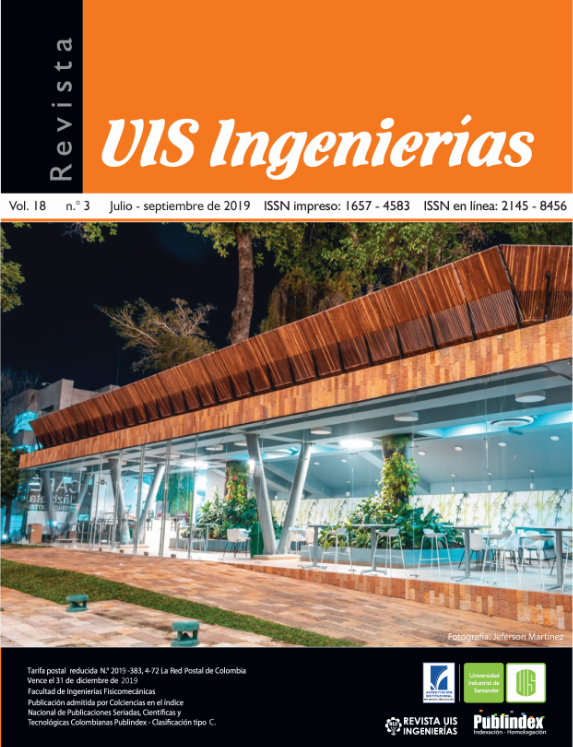Publicado 2019-03-26
Palabras clave
- combustión sin llama,
- CFD,
- eficiencia,
- gas natural,
- rendimiento energético
Cómo citar
Resumen
La creciente demanda energética y el aumento de las emisiones contaminantes son una grave problemática en la actualidad. El aumento de la eficiencia es una de las principales alternativas para reducir tanto el consumo de combustibles como la cantidad de contaminantes. En este sentido, el régimen de combustión sin llama con quemadores regenerativos se presenta como una tecnología que permite de forma simultánea alcanzar estas características. En el presente estudio se llevó a cabo la evaluación energética de forma experimental de un horno operando a 25 kW en el régimen de combustión sin llama, usando gas natural como combustible. De forma adicional se realizó una simulación CFD para evaluar la capacidad de predicción de los modelos seleccionados. Los resultados obtenidos del balance de energía muestran que la eficiencia térmica del horno bajo el mencionado régimen supera en un 10 % adicional la alcanzada en combustión convencional, además de obtener niveles de emisiones sumamente bajos. Los modelos seleccionados reproducen las tendencias generales del régimen y, sin embargo, subestiman las tasas de reacción dentro del proceso de combustión del CH4.
Descargas
Referencias
[2] M. Höök and X. Tang, “Depletion of fossil fuels and anthropogenic climate change—A review,” Energy Policy, vol. 52, pp. 797–809, 2013. doi: 10.1016/J.ENPOL.2012.10.046
[3] E. A. Abdelaziz, R. Saidur, and S. Mekhilef, “A review on energy saving strategies in industrial sector,” Renew. Sustain. Energy Rev., vol. 15, no. 1, pp. 150–168, Jan. 2011. doi: 10.1016/J.RSER.2010.09.003
[4] H. Dunkelberg et al., “Optimization of the energy supply in the plastics industry to reduce the primary energy demand,” J. Clean. Prod., vol. 192, pp. 790–800, Aug. 2018. doi: 10.1016/J.JCLEPRO.2018.04.254
[5] S. Zhou, Y. Wang, Z. Yuan, and X. Ou, “Peak energy consumption and CO2 emissions in China’s industrial sector,” Energy Strateg. Rev., vol. 20, pp. 113–123, Apr. 2018. doi: 10.1016/J.ESR.2018.02.001
[6] F. Rehermann and M. Pablo-Romero, “Economic growth and transport energy consumption in the Latin American and Caribbean countries,” Energy Policy, vol. 122, pp. 518–527, Nov. 2018. doi: 10.1016/J.ENPOL.2018.08.006
[7] A. Shahsavari and M. Akbari, “Potential of solar energy in developing countries for reducing energy-related emissions,” Renew. Sustain. Energy Rev., vol. 90, pp. 275–291, Jul. 2018. doi: 10.1016/J.RSER.2018.03.065
[8] A. Cavaliere and M. de Joannon, “Mild Combustion,” Prog. Energy Combust. Sci., vol. 30, no. 4, pp. 329–366, Jan. 2004. doi: 10.1016/J.PECS.2004.02.003
[9] J. A. Wünning and J. Wuenning, “Flameless oxidation to reduce thermal no-formation,” Prog. Energy Combust. Sci., vol. 23, pp. 81–94, 1997. doi: 10.1016/S0360-1285(97)00006-3
[10] A. Amell, L. Rubio, Y. Cadavid, and C. Echeverri, “Informe final del proyecto: Análisis de las necesidades tecnológicas para la mitigación del cambio climático en el sector industrial colombiano”, Ministerio de Medio Ambiente y Desarrollo Sostenible, Colombia, abr. 2013.
[11] A. C. Medina-Jimenez and J. E. Jaramillo-Ibarra, “Recuperación energética y análisis térmico del proceso de cocción en la industria cerámica,” Rev. UIS Ing., vol. 18, no. 1, pp. 81–98, 2019. doi: 10.18273/revuin.v18n1-2019007
[12] W. Yang and W. Blasiak, “Numerical simulation of properties of a LPG flame with high-temperature air,” Int. J. Therm. Sci., vol. 44, no. 10, pp. 973–985, Oct. 2005. doi: 10.1016/J.IJTHERMALSCI.2005.03.001
[13] P. Li, F. Wang, J. Mi, B. B. Dally, and Z. Mei, “MILD Combustion under Different Premixing Patterns and Characteristics of the Reaction Regime,” Energy & Fuels, vol. 28, no. 3, pp. 2211–2226, 2014. doi: 10.1021/ef402357t
[14] Y. Tu, H. Liu, S. Chen, Z. Liu, H. Zhao, and C. Zheng, “Effects of furnace chamber shape on the MILD combustion of natural gas,” Appl. Therm. Eng., vol. 76, pp. 64–75, Feb. 2015. doi: 10.1016/J.APPLTHERMALENG.2014.11.007
[15] Y. Tu et al., “MILD combustion of natural gas using low preheating temperature air in an industrial furnace,” Fuel Process. Technol., vol. 156, pp. 72–81, Feb. 2017. doi: 10.1016/J.FUPROC.2016.10.024
[16] B. Herrera and A. A. Amell, “Desarrollo y evaluación de una cámara de combustión sin llama,” Ph.D. dissertation, Universidad de Antioquia, 2009.
[17] C. Sepúlveda and A. A. Amell, “Desarrollo y evaluación de un quemador auto regenerativo para la combustión sin llama del gas natural,” Ph.D. dissertation, Universidad de Antioquia, 2009.
[18] C. Galletti, A. Parente, M. Derudi, R. Rota, and L. Tognotti, “Numerical and experimental analysis of NO emissions from a lab-scale burner fed with hydrogen-enriched fuels and operating in MILD combustion,” Int. J. Hydrogen Energy, vol. 34, no. 19, pp. 8339–8351, Oct. 2009. doi: 10.1016/J.IJHYDENE. 2008.09.058
[19] A. Parente, C. Galletti, and L. Tognotti, “Effect of the combustion model and kinetic mechanism on the MILD combustion in an industrial burner fed with hydrogen enriched fuels,” Int. J. Hydrogen Energy, vol. 33, no. 24, pp. 7553–7564, Dec. 2008. doi: 10.1016/J.IJHYDENE.2008.09.058
[20] A. Delgado, L. Olmos, and S. Rivero, “Comparative study of the indicated cycle of a diesel engine using simulation CFD and experimental data,” Rev.UIS.Ingenierías, vol. 13, no. 1, pp. 23–31, 2014.
[21] L. Wang, Z. Liu, S. Chen, and C. Zheng, “Comparison of Different Global Combustion Mechanisms Under Hot and Diluted Oxidation Conditions,” Combust. Sci. Technol., vol. 184, no. 2, pp. 259–276, 2012. doi: 10.1080/00102202.2011.635612
[22] S. Chen and C. Zheng, “Counterflow diffusion flame of hydrogen-enriched biogas under MILD oxy-fuel condition,” Int. J. Hydrogen Energy, vol. 36, no. 23, pp. 15403–15413, Nov. 2011. doi: 10.1016/J.IJHYDENE.2011.09.002
[23] A. F. Colorado, B. A. Herrera, and A. A. Amell, “Performance of a Flameless combustion furnace using biogas and natural gas,” Bioresour. Technol., vol. 101, no. 7, pp. 2443–2449, Apr. 2010. doi: 10.1016/J.BIORTECH.2009.11.003.

